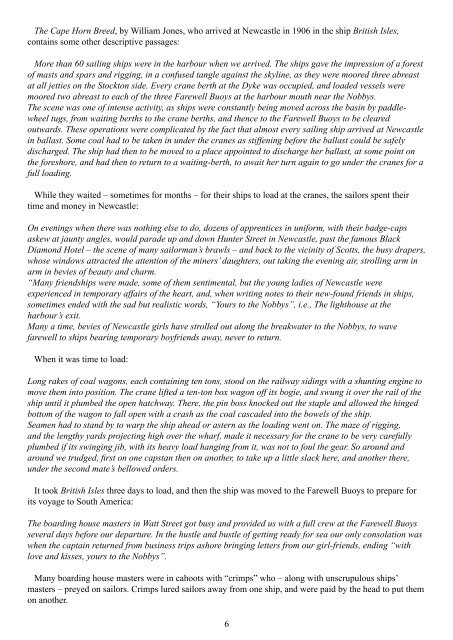Travelling Through Time in Newcastle & The Hunter
Draws on the Ken Magor collection, and photos from various other sources, to take the reader on a journey through time in the Hunter Region, from the days of sail to the 1980s, with an emphasis on transport by sea and land.
Draws on the Ken Magor collection, and photos from various other sources, to take the reader on a journey through time in the Hunter Region, from the days of sail to the 1980s, with an emphasis on transport by sea and land.
You also want an ePaper? Increase the reach of your titles
YUMPU automatically turns print PDFs into web optimized ePapers that Google loves.
<strong>The</strong> Cape Horn Breed, by William Jones, who arrived at <strong>Newcastle</strong> <strong>in</strong> 1906 <strong>in</strong> the ship British Isles,<br />
conta<strong>in</strong>s some other descriptive passages:<br />
More than 60 sail<strong>in</strong>g ships were <strong>in</strong> the harbour when we arrived. <strong>The</strong> ships gave the impression of a forest<br />
of masts and spars and rigg<strong>in</strong>g, <strong>in</strong> a confused tangle aga<strong>in</strong>st the skyl<strong>in</strong>e, as they were moored three abreast<br />
at all jetties on the Stockton side. Every crane berth at the Dyke was occupied, and loaded vessels were<br />
moored two abreast to each of the three Farewell Buoys at the harbour mouth near the Nobbys.<br />
<strong>The</strong> scene was one of <strong>in</strong>tense activity, as ships were constantly be<strong>in</strong>g moved across the bas<strong>in</strong> by paddlewheel<br />
tugs, from wait<strong>in</strong>g berths to the crane berths, and thence to the Farewell Buoys to be cleared<br />
outwards. <strong>The</strong>se operations were complicated by the fact that almost every sail<strong>in</strong>g ship arrived at <strong>Newcastle</strong><br />
<strong>in</strong> ballast. Some coal had to be taken <strong>in</strong> under the cranes as stiffen<strong>in</strong>g before the ballast could be safely<br />
discharged. <strong>The</strong> ship had then to be moved to a place appo<strong>in</strong>ted to discharge her ballast, at some po<strong>in</strong>t on<br />
the foreshore, and had then to return to a wait<strong>in</strong>g-berth, to await her turn aga<strong>in</strong> to go under the cranes for a<br />
full load<strong>in</strong>g.<br />
While they waited – sometimes for months – for their ships to load at the cranes, the sailors spent their<br />
time and money <strong>in</strong> <strong>Newcastle</strong>:<br />
On even<strong>in</strong>gs when there was noth<strong>in</strong>g else to do, dozens of apprentices <strong>in</strong> uniform, with their badge-caps<br />
askew at jaunty angles, would parade up and down <strong>Hunter</strong> Street <strong>in</strong> <strong>Newcastle</strong>, past the famous Black<br />
Diamond Hotel – the scene of many sailorman’s brawls – and back to the vic<strong>in</strong>ity of Scotts, the busy drapers,<br />
whose w<strong>in</strong>dows attracted the attention of the m<strong>in</strong>ers’ daughters, out tak<strong>in</strong>g the even<strong>in</strong>g air, stroll<strong>in</strong>g arm <strong>in</strong><br />
arm <strong>in</strong> bevies of beauty and charm.<br />
“Many friendships were made, some of them sentimental, but the young ladies of <strong>Newcastle</strong> were<br />
experienced <strong>in</strong> temporary affairs of the heart, and, when writ<strong>in</strong>g notes to their new-found friends <strong>in</strong> ships,<br />
sometimes ended with the sad but realistic words, “Yours to the Nobbys”, i.e., <strong>The</strong> lighthouse at the<br />
harbour’s exit.<br />
Many a time, bevies of <strong>Newcastle</strong> girls have strolled out along the breakwater to the Nobbys, to wave<br />
farewell to ships bear<strong>in</strong>g temporary boyfriends away, never to return.<br />
When it was time to load:<br />
Long rakes of coal wagons, each conta<strong>in</strong><strong>in</strong>g ten tons, stood on the railway sid<strong>in</strong>gs with a shunt<strong>in</strong>g eng<strong>in</strong>e to<br />
move them <strong>in</strong>to position. <strong>The</strong> crane lifted a ten-ton box wagon off its bogie, and swung it over the rail of the<br />
ship until it plumbed the open hatchway. <strong>The</strong>re, the p<strong>in</strong> boss knocked out the staple and allowed the h<strong>in</strong>ged<br />
bottom of the wagon to fall open with a crash as the coal cascaded <strong>in</strong>to the bowels of the ship.<br />
Seamen had to stand by to warp the ship ahead or astern as the load<strong>in</strong>g went on. <strong>The</strong> maze of rigg<strong>in</strong>g,<br />
and the lengthy yards project<strong>in</strong>g high over the wharf, made it necessary for the crane to be very carefully<br />
plumbed if its sw<strong>in</strong>g<strong>in</strong>g jib, with its heavy load hang<strong>in</strong>g from it, was not to foul the gear. So around and<br />
around we trudged, first on one capstan then on another, to take up a little slack here, and another there,<br />
under the second mate’s bellowed orders.<br />
It took British Isles three days to load, and then the ship was moved to the Farewell Buoys to prepare for<br />
its voyage to South America:<br />
<strong>The</strong> board<strong>in</strong>g house masters <strong>in</strong> Watt Street got busy and provided us with a full crew at the Farewell Buoys<br />
several days before our departure. In the hustle and bustle of gett<strong>in</strong>g ready for sea our only consolation was<br />
when the capta<strong>in</strong> returned from bus<strong>in</strong>ess trips ashore br<strong>in</strong>g<strong>in</strong>g letters from our girl-friends, end<strong>in</strong>g “with<br />
love and kisses, yours to the Nobbys”.<br />
Many board<strong>in</strong>g house masters were <strong>in</strong> cahoots with “crimps” who – along with unscrupulous ships’<br />
masters – preyed on sailors. Crimps lured sailors away from one ship, and were paid by the head to put them<br />
on another.<br />
6




